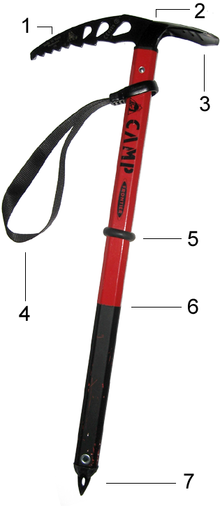Ice axe

1 – pick
2 – head
3 – adze
4 – leash
5 – leash stop
6 – shaft with rubber grip
7 – spike
An ice axe (AmE) or ice pick (outside the USA) is a multi-purpose ice and snow tool used by mountaineers both in the ascent and descent of routes which involve frozen conditions. It can be held and employed in a number of different ways, depending on the terrain encountered. In its simplest role, the ice axe is used like a walking stick in the uphill hand, the mountaineer holding the head in the centre, with the pick pointing to the rear. It can also be buried pick down, the rope tied around the shaft to form a secure anchor on which to bring up a second climber, or buried vertically to form a stomp belay. The adze is used to cut footsteps (sometimes known as pigeon holes), as well as scoop seats in the hillside and trenches to bury an ice axe belay.[1] An ice axe is not only used as an aid to climbing, but also as a means of self-arrest in the event of a downhill slip. The long-handled alpenstock was a predecessor to the modern ice axe.
Most ice axes meet design and manufacturing standards of organizations such as the Union Internationale des Associations d'Alpinisme (UIAA) or European Committee for Standardization. There are two classifications of ice axe, Basic and Technical. Basic ice axes are designed for use in snow conditions for general mountaineering, and are adequate for basic support and self-arrest. Technical ice axes, which may have curved shafts, are used for steep or vertical ice climbing.
Components
An ice axe consists of at least five components:
- Head — usually made of steel and featuring a pick and adze. A hole in the center is provided for attaching a wrist leash or carabiner.
- Pick — the toothed pointed end of the head, typically slightly curved (aiding both in ergonomics and self-arrest).
- Adze — the flat, wide end of the head used for chopping steps in hard snow and ice.
- Shaft — straight or slightly angled, typically wider front-to-back than side-to-side, flat on the sides and smoothly rounded on the ends. Traditional shafts were made of wood, but are now almost exclusively of lightweight metals (such as aluminum or titanium) or composite (including fiberglass, Kevlar or carbon filament).
- Spike, or ferrule — a steel point at the base of the shaft used for balance and safety when the axe is held by its head in walking stick fashion.
Accessories


Common ice axe accessories include:
- Leash — nylon webbing with an adjustable loop for securing the axe to hand. Often secured by a ring constrained to slide a limited distance on the shaft.
- Leash stop — a rubber keeper or metal stud preventing the leash from slipping off of the ice axe.
- Snow basket — similar to baskets on ski poles, temporarily mounted on the shaft close to the spike to keep the shaft from sinking into soft snow.
- Pick and adze guard — a cover to protect from sharp edges and points when the axe is not being used.
- Spike guard — a cover to protect from the sharp spike when the axe is not being used.
Size
Ice-axe spike-to-head lengths generally range from 60 to 90 cm (or about 24 to 36 in.). This is too short to be used as a walking stick on level ground (the way its forebearer, the 5-foot (1.5 m) 19th century alpenstock, was), but is ergonomic when ascending steep slopes. Ski mountaineers often carry shorter ice axes (50–55 cm) for emergency use if unexpected conditions are encountered.
History of the ice axe


The antecedent of the ice axe was the alpenstock, a long wooden pole with an iron spike tip, used by shepherds for travel on snowfields and glaciers in the Alps since the Middle Ages. On August 8, 1786, Jacques Balmat and Michel-Gabriel Paccard made the first ascent of Mont Blanc. Balmat, a chamois hunter and crystal collector, had experience with high mountain travel, and Paccard had made previous attempts to climb the peak. Illustrations show Balmat carrying two separate tools that would later be merged into the ice axe – an alpenstock (or baton) and a small axe that could be used to chop steps on icy slopes.
According to the earliest manufacturer of ice axes, Grivel, these two tools were merged to create the first true ice axe around 1840. Early ice axes had a vertical adze, with the cutting edge aligned with the direction of the shaft, as in a conventional axe. This design lasted until at least 1860, but eventually the adze was rotated to the current position, perpendicular to the direction of the shaft. The Italian Alpine Club published a book in 1889 entitled Fiorio e Ratti – The dangers of mountaineering and rules to avoid them, which recommended ice axes as among "the inseparable companions of the mountaineer".[2]
In the late 19th century, the typical ice axe shaft measured 120–130 cm in length. British climber Oscar Eckenstein started the trend toward shorter ice axes with a lighter model measuring 85–86 cm. Initially, this innovation was criticized by well-known climbers of the era, including Martin Conway, a prominent member of the Alpine Club, who was the leader of an early expedition to the Baltoro region near K2 in 1892 of which Eckenstein was a member.[3]
Early ice axes had picks and adzes of about equal lengths. By the beginning of the 20th century, the pick lengthened to about twice the length of the adze. Improvements in crampon design (pioneered by Eckenstein in 1908) and ice climbing technique led to use of shorter, lighter ice axes appropriate to steeper ice climbs in the period between the world wars.[2]
A famous rescue involving an ice axe took place during the Third American Karakoram Expedition to K2 in 1953. One of the climbers, Art Gilkey, was incapacitated by a pulmonary embolism. The other climbers attempted to rescue him by lowering him down the mountain by rope, wrapped in a sleeping bag. While crossing a steep ice sheet, a slip caused Gilkey and five other climbers to begin falling down a steep slope. Climber Pete Schoening wedged his ice axe alongside a boulder, and managed to belay the roped climbers, saving their lives. However, Gilkey was swept away by an avalanche and was killed.[4] Schoening's ice axe is now on display at the Bradford Washburn American Mountaineering Museum in Golden, Colorado.[5]
In 1966, Yvon Chouinard led a dramatic redesign of ice axes, working with a reluctant manufacturer Charlet to develop a 55-cm ice axe with a dramatically curved pick. Chouinard believed that "a curve compatible with the arc of the axe's swing would allow the pick to stay put better in the ice. I had noticed that a standard pick would often pop out when I placed my weight on it." Chouinard's idea worked and began a period of innovation in ice axe design.[6]
In 1978, the Safety Commission of the Union Internationale des Associations d'Alpinisme (UIAA) established formal standards for ice axe safety and performance. This led to the replacement of the traditional wooden shaft by metal alloy shafts. Ergonomically curved handles became widespread in 1986.[2] Use of modern aluminum alloys have led to a dramatic reduction in the weight of some ice axes. One model now on the market, the C.A.M.P. Corsa, weighs only 205 grams with a 50 cm long shaft. One expert rated this lightweight ice axe as "ideal for low angle glacier travel" but said he "craved the solid and secure heft of a true steel mountain ax" in more demanding steep alpine conditions.[7]
Use as a weapon
A mountaineering ice axe, often referred to as an "ice pick" (incorrectly so in the case of the USA),[8] was used in the assassination of Leon Trotsky by Ramón Mercader in Mexico City in 1940.[9] An ice axe was also used in the 2005 murder of Anthony Walker in the United Kingdom.[10]
Ice axes 1970s–2000s
-
A wooden handled ice axe from the mid 1970s. Length 29.5 " (75 cm). Weight 29.5 oz. (835 grams)
-
A metal handled ice axe from the late 1970s. Length 35.75" (90 cm). Weight 33.75 oz. (955 grams)
-
A lightweight CAMP Corsa ice axe purchased in 2007. Length 27.5" (70 cm). Weight 9.75 oz. (280 grams)
Attachment to rucksacks

On the frequently long approach to the snowline, or when the terrain does not warrant the use of an axe, it is common for ice axe(s) to be carried on a rucksack. Many rucksack models come with one ice axe loop (on the outside of the rucksack at its foot and generally in the middle), together with a device (a strap or a bungee cord) to attach it to the main body of the sack. Rucksacks with attachment points for two ice axes are also available (see example pictured), and these are popular for use with ice tools.
References
- ^ Cox, Steven M. and Kris Fulsaas, ed., ed. (2003-09). Mountaineering: The Freedom of the Hills (7 ed.). Seattle: The Mountaineers. ISBN 0898868289.
{{cite book}}:|editor=has generic name (help); Check date values in:|year=(help)CS1 maint: multiple names: editors list (link) - ^ a b c "History: The Ice-Axe". Grivel Mont Blanc - Since 1818. Retrieved 29 November 2009. [dead link]
- ^ Rowell, Galen (1977). In The Throne Room of the Mountain Gods. San Francisco: Sierra Club Books. pp. 36–40. ISBN 0-87156-184-0.
- ^ Rowell, Galen (1977). In The Throne Room of the Mountain Gods. San Francisco: Sierra Club Books. pp. 226–234. ISBN 0-87156-184-0.
- ^ "Artifacts". Bradford Washburn American Mountaineering Museum. Retrieved 27 November 2009.
- ^ Chouinard, Yvon (1978). Climbing Ice. San Francisco: Sierra Club Books with American Alpine Club. p. 27. ISBN 0-87156-208-1.
- ^ Goldie, Larry (September 25, 2008). "C.A.M.P. Corsa Ice Axe: Too Light for a Real Challenge". Alpinist 28: The Alpinist Mountain Standards. Retrieved 27 November 2009.
- ^ "Leon Trotsky murder weapon resurfaces in Mexico". USA Today. 11 July 2005. Retrieved 4 May 2010.
- ^ See Robert Conquest, The Great Terror: A Reassessment, Oxford University Press, 1991, ISBN 0195071328, p.418 for a detailed account
- ^ "Youth guilty of racist axe murder". BBC News. 2005-11-30. Retrieved 2007-01-21.
{{cite news}}:|first=missing|last=(help); Cite has empty unknown parameter:|coauthors=(help)
External links
- Ice Axe Buying Advice
- Ice Axe for Mountaineering
- History of the ice axe at grivel.com, as of 2006-08-27
- GoXplore Guides article on the Ice Axe



